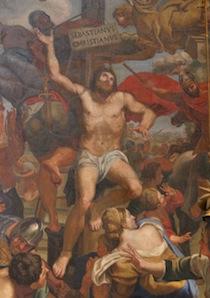Celebrating Pippin of the Pocket: 86/60/34
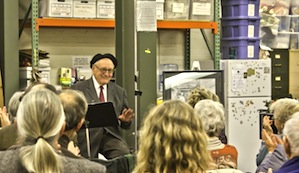 Donald Pippin marked his 86th birthday with business as usual: working. It was 60 years ago that he first started bringing chamber music and opera to the hungry i and Opus One in San Francisco’s North Beach, tickling the ivories at the Old Spaghetti Factory. These were the gigs that evolved into Pocket Opera 34 years ago, and Pippin’s nurturing of 99 works in 316 productions since.
Donald Pippin marked his 86th birthday with business as usual: working. It was 60 years ago that he first started bringing chamber music and opera to the hungry i and Opus One in San Francisco’s North Beach, tickling the ivories at the Old Spaghetti Factory. These were the gigs that evolved into Pocket Opera 34 years ago, and Pippin’s nurturing of 99 works in 316 productions since.
Pippin’s career before arriving here in 1952 wasn’t exactly a blank slate. After attending Harvard, he became an accompanist in George Balanchine’s School of American Ballet in New York City.
The celebration of the three anniversaries made for a special occasion on Friday in the Bryant Street costume shop shared by Pocket Opera and the Lamplighters. Soprano Heidi Moss Sali, a Pippin activist, took her project of creating CDs of Pippin’s wry and insightful spoken opera introductions to a new level.
There were already nine hours of existing recordings, but it was difficult to match up the varied audio sources, including extraction of audio from video. So Moss (as she is known on stage) used the occasion on Friday to record a “live” version of the introductions, before an audience gladly providing responses of laughter and response — even if these friends, supporters, and board members had heard many Pippinisms before.
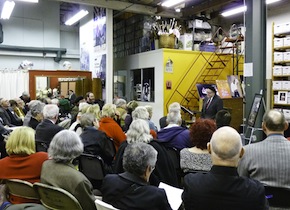
A fine example of Pippin's introductions is for his Offenbach in 4 Acts: "Offenbach was a tiny, frail, odd-looking person who weighed about a hundred pounds and seemed to live entirely on nervous energy. God's gift to the newspaper caricaturists of his day, he might have been easily mistaken for a bizarre character escaped from one of his own operettas. My favorite description: a cross between a bantam rooster and a grasshopper."
When Moss’ project is complete, the CD set will be sold to benefit Pocket Opera, and used for archival purposes. Why is she persisting in the project?
Donald’s legacy and gifts go well beyond Pocket Opera. It is not the performances, the sparse productions, the orchestra on stage, even performing opera in English that make him unique — it is his genius incarnation as the ultimate storyteller.He is paraphrasing every opera in his characteristic wit, never anachronistic, always captivating. To see an audience enthralled for two hours as he spoke, laughing at the unexpected (he finds a way to convey humor even in the midst of operatic drama), listening to every word he uttered in his characteristic delivery, made me realize that this is Donald, this is what needs to be carried on.
Those who dare not go to the opera, thinking it is for the old and fuddy-duddy snobbery, need to listen to Pippin and his words. This consummate storyteller can convince even the darkest of skeptics.
Pocket Opera's Season No. 35
The past 34 seasons have been quite a trip: the adventure, misadventure and romance of the operas themselves, but also seeing the vast number of singing careers Pocket Opera has launched over the years. For me, it’s been an unexpected joyride: at times perilous, always exhilarating.The season, all 2 p.m. matinees on Sundays:
- Mozart, Yanked From the Harem (Abduction From the Seraglio): March 4 and 11, Marines Memorial Theatre, S.F.; March 18, Hillside Club, Berkeley
- Rossini, Count Ory: April 15 and 22, Marines Memorial Theatre; April 29, Hillside Club
- Handel, Teseo: June 3, Marines Memorial Theatre; Hillside Club
- Bellini, Norma: June 24 and July 1, Marines Memorial Theatre; July 8, Hillside Club
- Offenbach, Tales of Hoffman: July 22 and 29, Marines Memorial Theatre; Aug. 5, Hillside Club
Debussy, Semi-Staged
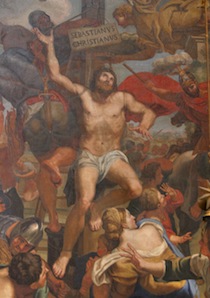
Michael Tilson Thomas will lead the orchestra and the S.F. Symphony Chorus in the rarely performed complete original music for the mystery play. Debussy composed the work in 1911, the same year as San Francisco Symphony’s founding.
At the premiere, the music accompanied a five-act mystery play depicting the martyrdom of Saint Sebastian, and was written as a vehicle for the Russian ballerina and Belle Époque figure Ida Rubinstein, a member of the Ballet Russe and the muse of numerous visual artists and musicians.
Saint Sebastian, a martyr venerated in the Roman Catholic and Orthodox Churches, is said to have been killed during the Roman emperor Diocletian’s persecution of Christians. Sebastian was a head archer who was shot to death by his own troop of archers.
MTT conducted the London Symphony Orchestra in a recording of the complete work in 1993, and led the last S.F. Symphony performances during his first season as music director in 1995:
It is one of my favorite pieces, an incredible mixture of beautiful harmonies, soaring voices, lush orchestral landscapes, and the spoken word. Every time I come back to this piece, I feel hypnotized being inside of it again. It is somehow touching, heartbreaking, haunting, and uses very simple ideas in the orchestra with a kind of glowing hue to take you from the quiet prelude to a dazzling climax when the saint enters into heaven.
Marcella DeCray
Marcella DeCray died last week at age 83. A vital force on the local music scene since moving to San Francisco in 1963, she played the harp with the city’s Symphony, Opera, and Ballet orchestras; founded the harp department at the S.F. Conservatory of Music, and taught there for 45 years. She also served as an officer of the World Harp Congress and the American Harp Society, and president of the Bay Area chapter.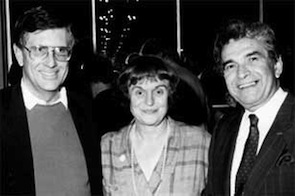
She was a cofounder of San Francisco Contemporary Music Players in 1973 — with Jean-Louis LeRoux and Charles Boone — and championed new music all her days. Posted on the SFCMP blog:
She was the first Executive Director of the group, from 1974 until 1988, and served on the board of directors from its inception in 1978 until 1989. In that time, she helped to establish the ensemble as the strong and well-respected organization that it remains today.Philadelphia-born, she became principal harpist of Eugene Ormandy’s Philadelphia Orchestra, where she played for 11 years. During that time, she also launched the harp departments at Baltimore’s Peabody Institute and the Aspen Music Festival.Our next concert on February 27, 2012, will be dedicated to the memory of her life.
Her son, Lexy Lowenstein, writes:
Her students knew her as an exacting teacher; her family knew her as a loving caretaker of her garden and many pets. All knew her dry wit and the gripping strength of her handshake. She was a lover of art and film and could also be a practical joker, enjoying a playful tease with her three adoring grandchildren. The warm home she created became a place where musicians and grandchildren would play with equal fervor.S.F. Ballet Concertmaster Roy Malan said of her: “To me, Marcella has always been an inspiration both as a great artist and as a consummate professional. On top of that, she is by far the most admired and beloved member of our orchestra.”
Marcella is survived by her husband, Malcolm McAfee; her children, Lexy and Lael Loewenstein; grandchildren; and other family members. Donations in her memory may be sent to the S.F. Conservatory of Music.
Great Gatsby on Ensemble Parallèle Playlist
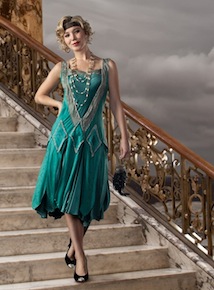
Nicole Paiement’s next contemporary opera offering with her Ensemble Parallèle is the premiere of Jacques Desjardins’ chamber orchestration of John Harbison’s opera The Great Gatsby. Performances, Feb. 10–12, will be held in the YBCA Novellus Theater.
Based on the F. Scott Fitzgerald novel, the opera was commissioned by the Metropolitan Opera and premiered in 1999, with subsequent performances at the Lyric Opera in Chicago.
The cast is headed by lyric tenor Marco Panuccio as Jay Gatsby; he recently sang Des Grieux in Massenet’s Manon for Lyric Opera of Chicago. Soprano Susannah Biller, who portrayed Eurydice in Ensemble Parallèle’s spring 2011 production of Philip Glass’ Orphèe, is featured as Daisy Buchanan.
Baritone Jason Detwiler, St. Plan in the company’s summer 2011 production of Four Saints in Three Acts, is Nick Carraway; tenor Dan Snyder, who portrayed Dexter in the world premiere of Heart of a Soldier at San Francisco Opera, is Tom Buchanan; baritone Bojan Knezevic, who sang the title role of Wozzeck in the 2010 Ensemble Parallèle production, is George Wilson.
Mezzo Erin Neff, the Margret in Wozzeck, is cast as Myrtle Wilson, and Julienne Walker, a graduate student at the S.F. Conservatory of Music, is Jordan Baker.
Brian Staufenbiel heads the artistic team of scenic and lighting designer Matthew Antaky, video artist Austin Forbord, costume designer Christine Crook, and wig and makeup designer Jeanna Parham.
Cage Centennial: Get Lucky, the Culture of Chance
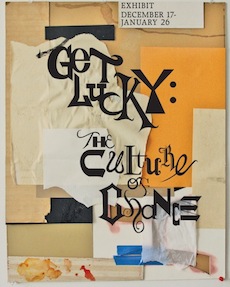 SOMArts Cultural Center is joining the centennial birthday celebration of John Cage with a multimedia exhibit, Get Lucky: The Culture of Chance, Dec. 17 – Jan. 26. Curators Justin Hoover and Hanna Regev are preparing “a look at a vast array of fine art practices investigating the implications of chance operation in the arts, and across cultural beliefs, values and practices.”
SOMArts Cultural Center is joining the centennial birthday celebration of John Cage with a multimedia exhibit, Get Lucky: The Culture of Chance, Dec. 17 – Jan. 26. Curators Justin Hoover and Hanna Regev are preparing “a look at a vast array of fine art practices investigating the implications of chance operation in the arts, and across cultural beliefs, values and practices.”
Site-specific installations, created by 29 artists, “explore varying levels of control in production, and experiment with structured randomness.” Get Lucky includes works that — and I quote — “conflate Wiccan-based Tarot practice and corporate culture, I-Ching with installation art, and the aesthetics of Zen pottery with Western abstract painting. John Cage, through his deep relationship with Eastern philosophies, opened the door for contemporary artists to experiment with varying levels of control and chance.”
I might hazard a guess that music for the exhibit will consist of multiple performances of Cage’s notorious 4'33" (4 minutes and 33 seconds of nothing but silence).
Shostakovich's Orango in L.A. Premiere
Before Esa-Pekka Salonen led performances of his Violin Concerto in Davies Hall, he stopped by in Los Angeles to conduct the Philharmonic’s world premiere of Shostakovich’s Prologue to Orango, paired with his Symphony No. 4.David Gregson reports in Opera West that the lost and only recently recovered work was written in 1936, while Shostakovich was working on Lady Macbeth of Mtsensk. Orango disappeared as Stalin’s wrath came down on the composer, and only the Prologue was eventually found and reconstructed.
Peter Sellars directed the work, featuring Merola alum baritone Eugene Brancoveanu and baritone Ryan McKinny.
Do You Prefer That People Next to You Talk or Tweet During a Concert?
As for me, give me liberty from distraction — or give them death. But the new thing, apparently, is a section for tweeting, according to the The Los Angeles Times:Perhaps the most unexpected thing about “tweet seats” is that they exist. Perhaps the second-most-unexpected thing about them is that they appear to be a growing trend.A tweet seat is a seat in a theater that has been approved by the theater for use by someone who would like to tweet a performance. Whip out your cellphone and start tweeting at a rock show and nobody will notice — the rest of audience is probably shooting cellphone pictures anyway. But try that at the opera and you’ll be glared at, unless you are in a tweet seat.
Tweet seats first started surfacing at the end of the ’00s. In 2009, the Lyric Opera in Kansas reserved 100 tweet seats for its final performance of Gilbert and Sullivan’s HMS Pinafore. In those seats (and only those seats) audience members could use their phones to look at tweeted content sent by the theater’s artistic director about the production, the scenery and whatever was happening on stage. Audience members were also encouraged to tweet questions in real time.
Guesses About the Next S.F. Opera Season
As usual, opera fans are getting ahead of the official word from the company — due next month — in guessing what’s coming to the War Memorial next year.The consensus, summarized by The Opera Tattler, and to be taken with lumps of sodium, is that for fall 2012, it’s:
- Verdi’s Rigoletto with Zeljko Lucic, Marco Vratogna, Francesco Demuro, and Aleksandra Kurzak
- Puccini’s Tosca with Patricia Racette
- Wagner’s Lohengrin
- Jake Heggie’s Moby-Dick
- Bellini’s I Capuleti e i Montecchi
Summer 2013:
- Mark Adamo’s The Gospel of Mary Magdalene
- Verdi’s Falstaff
- Offenbach’s Les Contes d’Hoffmann with Natalie Dessay
- Daniel Catán’s Florencia en el Amazonas
Nutcracker Statistics and Applause for the Ushers
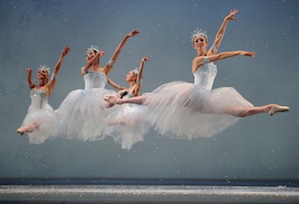
Here, where the country’s fascination with The Nutcracker began at the 1892 Petipa–Ivanov ballet’s American premiere in 1944, choreographed by Utah’s Willam Christensen, this annual rite of passage has become a major economic-educational force.
Popular as it is around the world, there is no match for the work’s ubiquity in the U.S.: Each year, there are some 800 productions spread over more than 120 cities. In San Francisco, the Nutcracker season that began on Friday consists of 31 performances, drawing an audience close to 100,000, and providing the company income in the millions. Sixty-seven seasons in the 3,200-seat War Memorial accommodated more than five million viewers.
With all those industrial-strength numbers, San Francisco Ballet’s current production, staged by Artistic Director Helgi Tomasson, is still an individual one-on-one experience.
As always, children make up almost half the audience, and the spectacular production serves as an irresistible introduction to ballet. At Saturday’s matinee, by the time the exquisite Grand Pas de Deux with Sarah Van Patten and Tiit Helimets arrived at the end, the ovation came from a community of balletomanes, regardless of age.
Michael Yeargan’s scenery, set in the days of the 1915 World’s Fair, and Martin Pakledinaz’s sumptuous costumes elicited “Oohs!” and “Ahs!,” especially during the battle between the mice and toy soldiers, the growing Christmas tree, and the biggest onstage blizzard seen in local Nutcracker history.
There is an essential component of the Nutcracker run that’s never mentioned. Unless you witness the twice-daily confluence of 3,200 people, you have no idea of the enormous task before the ushers, most of them volunteers. Children are the least of it — “at least, when they throw up, they feel better,” says a veteran usher who has seen it all.
More challenging are adults new to the Opera House, unaware that the performance starts on time, that there is no seating after the curtain goes up, that the booster cushions are for children only, that food and drink are not permitted, and similar inconveniences. Who deals with all that? Yes, it’s about time to take an usher to lunch.
Rachmaninov Biography Online
The full 100-minute Tony Palmer documentary on Sergei Rachmaninov is now available online.Palmer narrates this fascinating collection of home movies, concert footage, and interviews, with John Gielgud’s participation.
In several YouTube parts, unlike the all-in-one Rachmaninov documentary, Ken Russell’s Omnibus documentary about Richard Strauss is also available, beginning with Part 1.

